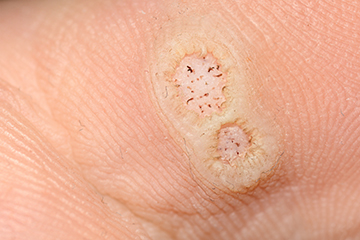
What are Plantar Warts?
Plantar warts are small growths that typically appear on the heels or other load-bearing parts of your feet. Plantar warts are caused by the Human Papillomavirus (HPV). There are more than 100 different strains of the HPV, but typically strains 1,2,4 and 57 cause plantar warts. These viruses enter the body through tiny cuts, lacerations, or other weak spots on the bottom parts of your feet. The virus infects the outer layer skin, at the lowest layer known as the Stratum Basale. Once inside, the virus begins to take over cellular function. Interestingly, the virus does not destroy the skin cell, nor does it cause antigen-presenting proteins on the cell wall. For these reasons, the immune system will not be activated. Another important feature of plantar warts is that they do not extend into the deeper layers of the dermis. Warts are a superficial viral infection.
Symptoms of Plantar Warts
To help identify if you have plantar warts, look for these signs and symptoms:
- A small, rough growth (lesion) on the bottom of your foot that may also be grainy and fleshy. These lesions are generally found on or around the base of the toes and forefoot or the heel.
- Hard, thickened skin (callus) over a well-defined "spot" on the skin, where a wart might have grown inward.
- Tiny black spots, which are usually called wart seeds but are actually small, clotted blood vessels.
- A lesion that disturbs the normal lines and ridges in the skin of your foot.
- Pain or tenderness when walking or standing.
Potential Causes of Plantar Warts
If skin cells become infected with HPV, the virus generally tends to make those cells grow quicker than the unaffected cells. This causes a wart to form. HPV is highly contagious, and therefore you need to be aware of potential situations or causes that may increase your chances of being infected. You are more inclined to get plantar warts if you:
- Have a weakened immune system, which makes it harder for your body to fight the virus.
- Walk around barefoot in public areas that are constantly wet, such as locker rooms, communal showers, or swimming pools.
- Have skin-to-skin contact with another person who has a wart.
- Share shoes or dirty socks that come into contact with both people’s bare feet.
Preventing Plantar Warts
To help avoid getting plantar warts, here are a few ways to prevent HPV from entering your body through your feet:
- Avoid direct contact with warts, including any other warts you may have. Wash your hands with hot water and soap after touching a wart.
- Keep your feet clean and dry. Change your shoes and socks daily.
- Wear water shoes or flip flops when walking around swimming pools and locker rooms.
- Don't pick at or scratch warts.
- Don’t share shoes with other people.
- Don't use the same foot routine products, such as an emery board, pumice stone or nail clipper on your warts as you use on your healthy skin and nails.
Treatment Options for Plantar Warts
Plantar warts are notoriously difficult to resolve. When the virus enters the skin cells it gains many of the protective features that the skin possesses. One of these features is that the virus gains the ability to regenerate. (Interestingly, the virus is not specifically coded for regeneration, but rather it incorporates these instructions from the healthy skin into its own DNA sequence. ) As a result, treatment must be reasonably aggressive and frequently requires several treatments before the virus is eradicated. Apart from the discomfort and unsightly appearance of the wart, it is important to remember that the primary function of the wart is to grow and spread, so prompt treatment is important. The most common treatment options for plantar warts include:
Autoimmune therapy
This treatment involves putting a tiny bit of the virus into the deeper layers of the skin. This helps to activate your immune system so it can fight off the virus.
Laser removal
The removal of warts using laser treatment carries a high success rate by vaporizing the tissue. Warts that have numerous thrombosed capillaries are the best candidate for laser therapy. Typically 2-3 treatments will be required to eradicate the wart. For smaller warts no local anesthesia is required; however, for larger warts (greater than 5 mm) local anesthesia is required.
Topical treatments
Topical treatments are typically the first line of therapy initiated when dealing with warts. This treatment is tolerated extremely well and can be used on pediatric and adult patients. Patients prefer this treatment because it causes little to no discomfort and will not cause any scarring of the tissue. No local anesthesia is required. Typically, 4-6 treatments are required to resolve the wart.
Excision Treatment
Excision of a wart is the single fastest method of eradicating a wart. This treatment option is typically used for warts greater than 5 mm, or warts that are resistant to topical therapy. Local anesthesia is used to numb the area, and the wart is simply excised. Usually, one treatment is sufficient to resolve the wart.
Contact the dedicated chiropodists at Medical Foot Solutions if you have any questions or want to book an appointment to address plantar warts or any other foot concerns you may have.

